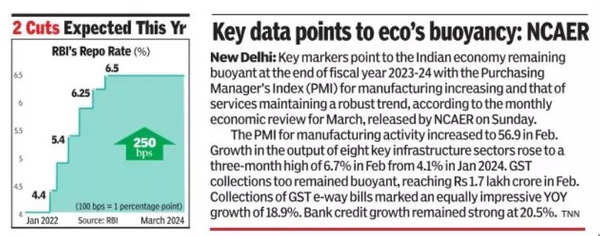[ad_1]
In its last policy meeting in Feb, RBI had retained the repo rate at 6.5% for the sixth consecutive meet while retaining the ‘withdrawal of accommodation’ stance.With Oct-Dec 2023 GDP growth surprising on the upside at 8.4%, RBI’s concern is entirely around inflation management.
While core inflation has declined below RBI’s target of 4%, periodic supply issues are causing food prices to hike. As a result, inflation is expected to be above 5% for the first half of 2024.
“Banking system liquidity has eased with active interventions by RBI and govt spending over the last month, which has softened inter-bank and short-term borrowing rates for bank and non-bank entities. In our view, when RBI eventually starts the easing cycle, we expect them to run liquidity surpluses and let the inter-bank rate trade below the repo rate,” said Santanu Sengupta, an economist with Goldman Sachs. The investment bank expects RBI to cut interest rates twice by 25 basis points (100bps = 1 percentage point) in July-Sept and Oct-Dec of 2024.

RBI has dialled back its hawkishness on liquidity management since the Feb meeting, allowing weighted average call rates to drift lower, said Rahul Bajoria, MD & head of emerging Asia economics at Barclays.
“Not much has changed since the last MPC meeting in Feb, with RBI overseeing an economy enjoying high growth and falling core inflation, amid stable macro stability parameters. Against this backdrop, we expect the MPC to keep the repo rate on hold at 6.5% and maintain the monetary policy stance at a ‘withdrawal of accommodation’,” said Bajoria.
Kaushik Das, chief economist, Deutsche Bank India, said there is a slight chance of the monetary policy committee voting for a change in stance. “We expect RBI to maintain a pause yet again in the April 5 policy, holding the repo rate steady at 6.5%. As far as the stance goes, we think there is a small likelihood that it could change to ‘neutral’ from the current ‘withdrawal of accommodation’, but if that happens, it will be a positive surprise for the market,” said Das.
We also published the following articles recently
S&P Global Ratings highlighted RBI’s stringent actions aiming to improve governance and transparency, potentially leading to higher capital costs and slower credit growth for financial institutions, while increasing compliance and transparency in the financial sector.
The utilisation rate of corneas in Maharashtra has significantly increased to 60% from 35-40% due to technological advancements, better preservation methods, increased awareness about donation, decisions on donor age, and various innovative medical procedures.
[ad_2]
